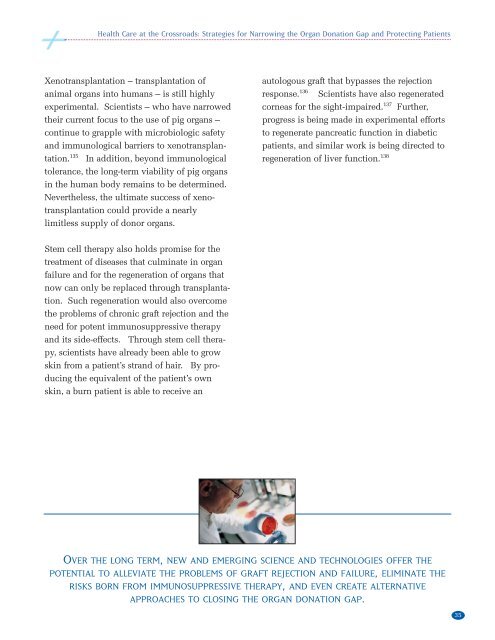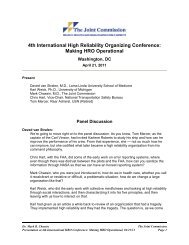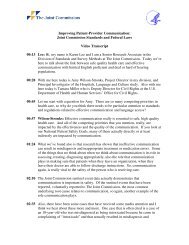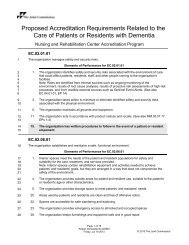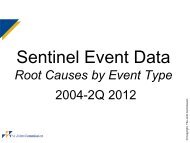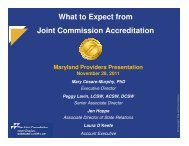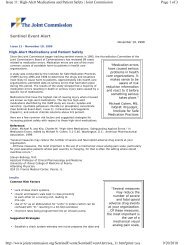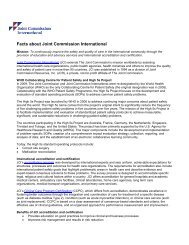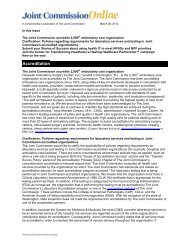Health Care at the Crossroads: Strategies for ... - Joint Commission
Health Care at the Crossroads: Strategies for ... - Joint Commission
Health Care at the Crossroads: Strategies for ... - Joint Commission
You also want an ePaper? Increase the reach of your titles
YUMPU automatically turns print PDFs into web optimized ePapers that Google loves.
<strong>Health</strong> <strong>Care</strong> <strong>at</strong> <strong>the</strong> <strong>Crossroads</strong>: Str<strong>at</strong>egies <strong>for</strong> Narrowing <strong>the</strong> Organ Don<strong>at</strong>ion Gap and Protecting P<strong>at</strong>ients<br />
Xenotransplant<strong>at</strong>ion – transplant<strong>at</strong>ion of<br />
animal organs into humans – is still highly<br />
experimental. Scientists – who have narrowed<br />
<strong>the</strong>ir current focus to <strong>the</strong> use of pig organs –<br />
continue to grapple with microbiologic safety<br />
and immunological barriers to xenotransplant<strong>at</strong>ion.<br />
135 In addition, beyond immunological<br />
tolerance, <strong>the</strong> long-term viability of pig organs<br />
in <strong>the</strong> human body remains to be determined.<br />
Never<strong>the</strong>less, <strong>the</strong> ultim<strong>at</strong>e success of xenotransplant<strong>at</strong>ion<br />
could provide a nearly<br />
limitless supply of donor organs.<br />
autologous graft th<strong>at</strong> bypasses <strong>the</strong> rejection<br />
response. 136 Scientists have also regener<strong>at</strong>ed<br />
corneas <strong>for</strong> <strong>the</strong> sight-impaired. 137 Fur<strong>the</strong>r,<br />
progress is being made in experimental ef<strong>for</strong>ts<br />
to regener<strong>at</strong>e pancre<strong>at</strong>ic function in diabetic<br />
p<strong>at</strong>ients, and similar work is being directed to<br />
regener<strong>at</strong>ion of liver function. 138<br />
Stem cell <strong>the</strong>rapy also holds promise <strong>for</strong> <strong>the</strong><br />
tre<strong>at</strong>ment of diseases th<strong>at</strong> culmin<strong>at</strong>e in organ<br />
failure and <strong>for</strong> <strong>the</strong> regener<strong>at</strong>ion of organs th<strong>at</strong><br />
now can only be replaced through transplant<strong>at</strong>ion.<br />
Such regener<strong>at</strong>ion would also overcome<br />
<strong>the</strong> problems of chronic graft rejection and <strong>the</strong><br />
need <strong>for</strong> potent immunosuppressive <strong>the</strong>rapy<br />
and its side-effects. Through stem cell <strong>the</strong>rapy,<br />
scientists have already been able to grow<br />
skin from a p<strong>at</strong>ient’s strand of hair. By producing<br />
<strong>the</strong> equivalent of <strong>the</strong> p<strong>at</strong>ient’s own<br />
skin, a burn p<strong>at</strong>ient is able to receive an<br />
OVER THE LONG TERM, NEW AND EMERGING SCIENCE AND TECHNOLOGIES OFFER THE<br />
POTENTIAL TO ALLEVIATE THE PROBLEMS OF GRAFT REJECTION AND FAILURE, ELIMINATE THE<br />
RISKS BORN FROM IMMUNOSUPPRESSIVE THERAPY, AND EVEN CREATE ALTERNATIVE<br />
APPROACHES TO CLOSING THE ORGAN DONATION GAP.<br />
35


